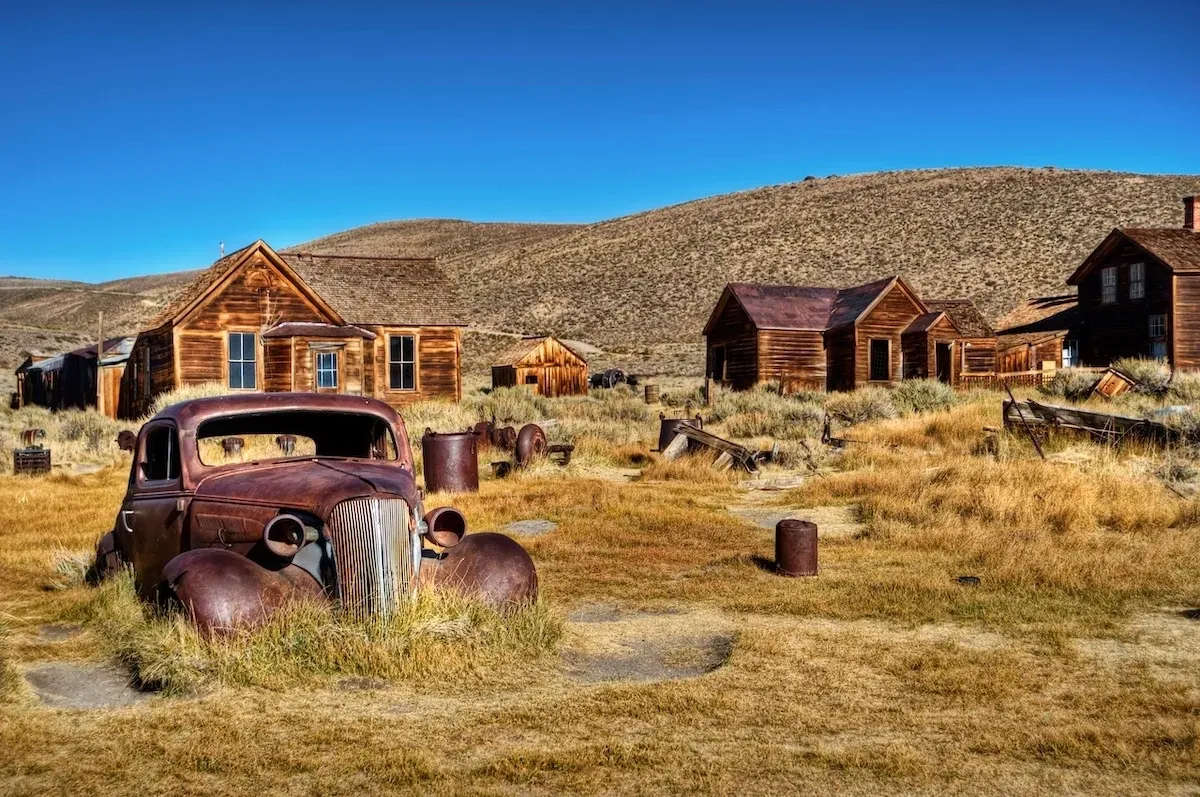Bodie is a deserted settlement situated in the Bodie Hills, east of the Sierra Nevada mountain range within Mono County, California, USA. It stands at an elevation of 8,379 feet, approximately 75 miles southeast of Lake Tahoe and 12 miles east-southeast of Bridgeport. Booming in 1876 following a lucrative gold discovery, Bodie boasted 2,000 structures and a population of 8,000 by 1879. However, over the years, it faded into abandonment, earning the designation of a ghost town around 1915.

Today, Bodie exists as a State Historic Park, with some parts of the town preserved in a state of “arrested decay.” Visitors can explore the town’s remnants, including tables with place settings and shops stocked with supplies, offering a glimpse into its past. Recognized by the U.S. Department of the Interior, the Bodie Historic District is a National Historic Landmark. It is also noted as a California Historical Landmark and officially became Bodie State Historic Park in 1962. The park welcomes around 200,000 visitors annually and receives partial support from the Bodie Foundation.

Bodie’s origins trace back to a mining camp established in 1859 following the gold discovery in the area, led by prospectors like W. S. Bodey. Unfortunately, Bodey met a tragic fate in November of the following year, perishing in a blizzard during a supply trip to Monoville. He never had the chance to witness the town named in his honor.
According to pioneer Judge J. G. McClinton, the name of the district evolved from “Bodey” to “Bodie” after a sign was lettered by a painter in the nearby boomtown of Aurora, naming it “Bodie Stables.” This alteration in spelling eventually became the accepted name for the town.

The gold discovery in Bodie occurred at a time when silver was also found in nearby Aurora and the Comstock Lode was discovered beneath Virginia City, Nevada. Despite the prosperity of these neighboring towns, Bodie initially struggled to attract significant attention. By 1868, only two companies had erected stamp mills in Bodie, and both ventures ended in failure.
However, in 1876, the Standard Company made a significant discovery of gold-bearing ore, leading to a dramatic transformation of Bodie from a secluded mining camp to a bustling Wild West boomtown. The discovery of substantial gold deposits in the nearby Bodie Mine in 1878 further fueled the town’s growth. By 1879, Bodie’s population had surged to approximately 7,000 to 10,000 people, with around 2,000 buildings dotting the landscape.

Legend has it that Bodie was California’s second or third largest city in 1880, but this claim is refuted by the U.S. Census data for that year. Nevertheless, Bodie’s mines were highly productive, yielding gold and silver valued at an estimated $34 million (in 1986 dollars, equivalent to $85 million in 2021) between 1860 and 1941.


The boom period in Bodie lasted from late 1877 through the mid- to late 1880s. The first newspaper, The Standard Pioneer Journal of Mono County, was established on October 10, 1877, initially as a weekly publication but later expanding to three times a week. This period also saw the construction of a telegraph line connecting Bodie with Bridgeport and Genoa, Nevada.
Expectations ran high during this era, with newspapers from California and Nevada predicting that Bodie would become the next Comstock Lode. These predictions attracted men from both states, eager to capitalize on the potential for another lucrative mining bonanza.

Bodie’s decline became apparent in 1880 and became more pronounced by the end of the year. The allure of promising mining booms in Butte, Montana; Tombstone, Arizona; and Utah drew men away from Bodie. The single miners who had flocked to the town in the 1870s seeking quick riches shifted their focus to these new opportunities, transforming Bodie into a more family-oriented community.
In 1882, despite the decrease in population, residents constructed the Methodist Church (which still stands today) and the Roman Catholic Church (though it burned down in 1928). However, despite the population decline, the mines continued to thrive. In 1881, they recorded a substantial ore production of $3.1 million.
Additionally, in 1881, the Bodie Railway & Lumber Company was established. This narrow-gauge railroad transported lumber, cordwood, and mine timbers from Mono Mills, located south of Mono Lake.

In the early 1890s, Bodie underwent a brief resurgence driven by technological advancements in the mining industry. The introduction of the newly invented cyanide process in 1890 held the promise of recovering gold and silver from discarded mill tailings and previously overlooked low-grade ore bodies.
By 1892, the Standard Company took a significant step forward by constructing its own hydroelectric plant approximately 13 miles away at Dynamo Pond. This pioneering installation generated a maximum of 130 horsepower and 3,530 volts of alternating current (AC), marking the nation’s first long-distance transmissions of electricity.

